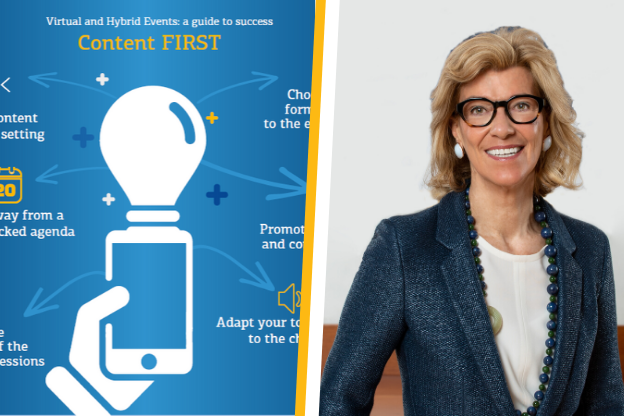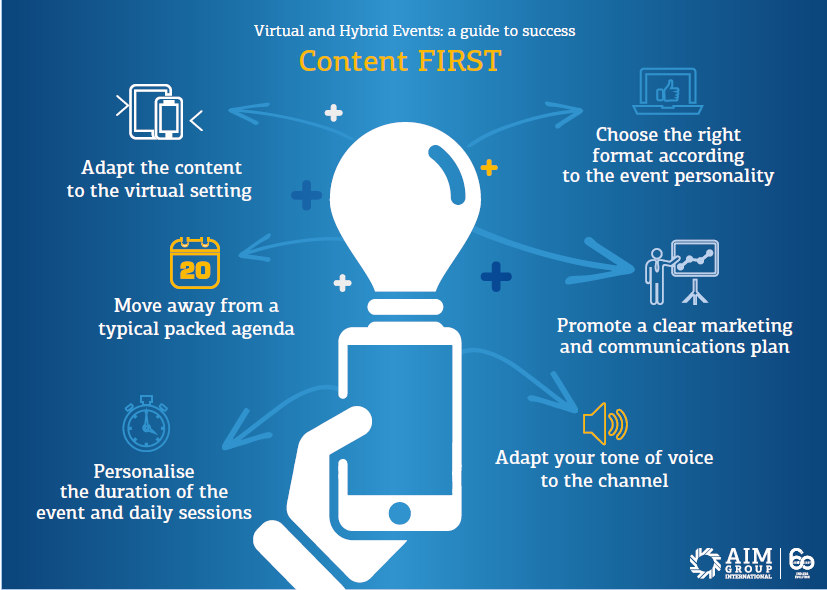
Virtual and Hybrid Events: a guide to success 1/7
When planning a virtual or hybrid event it is crucial to choose the right format and technology, adapting content, agenda and channels to satisfy the attendees, speakers and sponsors. Our senior expert designs a brief manual with 6 main steps to follow.
The global pandemic has forced the event industry to embrace and explore the realm of virtual meetings like never before. While this digital pivot was a necessity, in unprecedented circumstances, the need to become digital in a very short time paved the way for virtual events with little or no strategy and design. The execution of these early meetings was far from creative and innovative.
Virtual meetings are expected to become an integral part of corporate and association meeting strategies. Virtual is here to stay. But the ways that organizations deliver experiences will change. At the very least, there will be much more hybrid execution in the event space, and it will become predominant.
Meeting technology is going to change forever the face of the meetings industry. Once people get used to the new experiences and innovation, there will be further expansion of digital meetings, but with revised practices and more professionalism.
The organization of a virtual and hybrid event requires a DCO, not a typo (!), this is a DIGITAL CONFERENCE ORGANIZER, a team with specific knowledge and competences, including technical ones and the ability to support and offer strategic guidance to events with full or partial digital components.
Before embarking on a new virtual or hybrid event, you need to follow a strategic map and complete a number of actions. Our senior expert Annalisa Ponchia, Director of Innovation and Customer Experience AIM Group International, can lead us through a methodology in six easy steps (plus one bonus tip).
- Content FIRST. The right content for the digital format
When going virtual, clients and event professionals alike tend to think about the best technical solution over the type of content that you need to disseminate. An inspiring and highly educational event can still be delivered in a virtual format, but you may have to adapt the content to the format, the agenda, the topics and presentation style. You also need to bear in mind the personal expectations and needs of the online attendees.
So, linking the content with the right communication format and style should come first.
Depending on the type of content and the objectives of the event you may adapt your tone of voice, session formats and tools:
- Stay committed to the original value proposition. If you want to educate and deliver the same amount of content as the planned face-to-face event and replicate the experience as close as possible to the original, then you need to focus on using simple, clear online platforms over fancy visuals, your top priority is a robust software and a user friendly interface.
- Be recognised as a trailblazer for innovation. If you want to organise an event that is completely different and surprise and entertain your audience, then aim for 3D sophisticated appealing visuals, create immersive experience, highly interactive sessions and entertaining networking moments.
- Stay connected and expand your community (members, employees, clients). If you want to set the right attendee expectations and broaden your potential audience, plan a clear marketing and communications plan to drive strong engagement (before, during and after the event), favour live panels and small group discussions to pre-recorded presentations, emphasize quality over quantity. Consider offering only some of the most interesting sessions live and the other ones on demand.
If your aim is to embrace these three scenarios, then you still need to pay attention to the content. The first rule is to trim and adapt your content to the virtual setting. Your audience is demanding innovation and to get access to the latest developments, no matter what the virtual platform is.
Your first priority is to address the agenda, the topics and the speakers and make sure they reflect the new reality not the previously planned face-to-face one. Do not hesitate to move away from a typical packed agenda by changing the duration of the event and daily sessions; the number of live presentations and the ways to engage your participants.

– TO BE CONTINUED –

